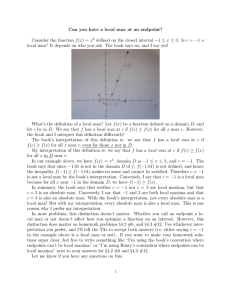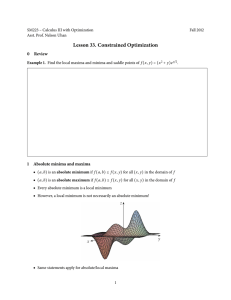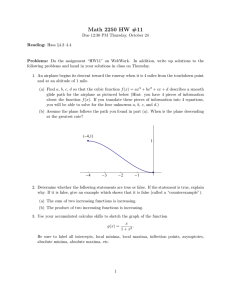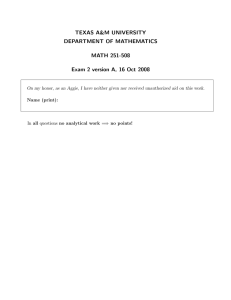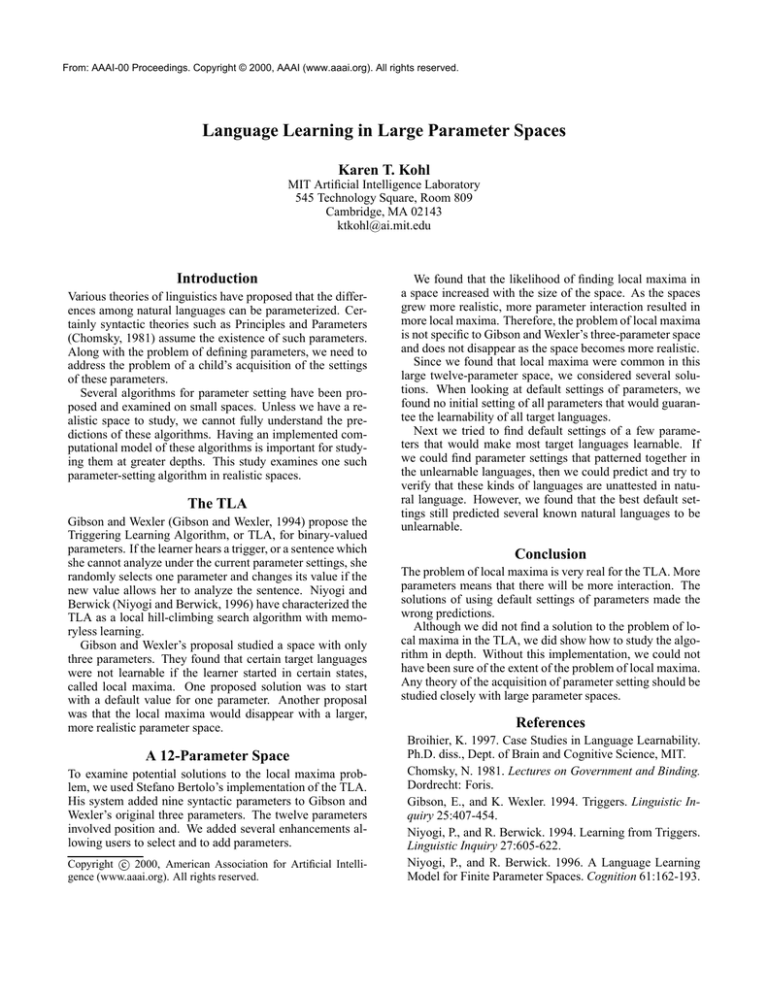
From: AAAI-00 Proceedings. Copyright © 2000, AAAI (www.aaai.org). All rights reserved.
Language Learning in Large Parameter Spaces
Karen T. Kohl
MIT Artificial Intelligence Laboratory
545 Technology Square, Room 809
Cambridge, MA 02143
ktkohl@ai.mit.edu
Introduction
Various theories of linguistics have proposed that the differences among natural languages can be parameterized. Certainly syntactic theories such as Principles and Parameters
(Chomsky, 1981) assume the existence of such parameters.
Along with the problem of defining parameters, we need to
address the problem of a child’s acquisition of the settings
of these parameters.
Several algorithms for parameter setting have been proposed and examined on small spaces. Unless we have a realistic space to study, we cannot fully understand the predictions of these algorithms. Having an implemented computational model of these algorithms is important for studying them at greater depths. This study examines one such
parameter-setting algorithm in realistic spaces.
The TLA
Gibson and Wexler (Gibson and Wexler, 1994) propose the
Triggering Learning Algorithm, or TLA, for binary-valued
parameters. If the learner hears a trigger, or a sentence which
she cannot analyze under the current parameter settings, she
randomly selects one parameter and changes its value if the
new value allows her to analyze the sentence. Niyogi and
Berwick (Niyogi and Berwick, 1996) have characterized the
TLA as a local hill-climbing search algorithm with memoryless learning.
Gibson and Wexler’s proposal studied a space with only
three parameters. They found that certain target languages
were not learnable if the learner started in certain states,
called local maxima. One proposed solution was to start
with a default value for one parameter. Another proposal
was that the local maxima would disappear with a larger,
more realistic parameter space.
A 12-Parameter Space
To examine potential solutions to the local maxima problem, we used Stefano Bertolo’s implementation of the TLA.
His system added nine syntactic parameters to Gibson and
Wexler’s original three parameters. The twelve parameters
involved position and. We added several enhancements allowing users to select and to add parameters.
Copyright c 2000, American Association for Artificial Intelligence (www.aaai.org). All rights reserved.
We found that the likelihood of finding local maxima in
a space increased with the size of the space. As the spaces
grew more realistic, more parameter interaction resulted in
more local maxima. Therefore, the problem of local maxima
is not specific to Gibson and Wexler’s three-parameter space
and does not disappear as the space becomes more realistic.
Since we found that local maxima were common in this
large twelve-parameter space, we considered several solutions. When looking at default settings of parameters, we
found no initial setting of all parameters that would guarantee the learnability of all target languages.
Next we tried to find default settings of a few parameters that would make most target languages learnable. If
we could find parameter settings that patterned together in
the unlearnable languages, then we could predict and try to
verify that these kinds of languages are unattested in natural language. However, we found that the best default settings still predicted several known natural languages to be
unlearnable.
Conclusion
The problem of local maxima is very real for the TLA. More
parameters means that there will be more interaction. The
solutions of using default settings of parameters made the
wrong predictions.
Although we did not find a solution to the problem of local maxima in the TLA, we did show how to study the algorithm in depth. Without this implementation, we could not
have been sure of the extent of the problem of local maxima.
Any theory of the acquisition of parameter setting should be
studied closely with large parameter spaces.
References
Broihier, K. 1997. Case Studies in Language Learnability.
Ph.D. diss., Dept. of Brain and Cognitive Science, MIT.
Chomsky, N. 1981. Lectures on Government and Binding.
Dordrecht: Foris.
Gibson, E., and K. Wexler. 1994. Triggers. Linguistic Inquiry 25:407-454.
Niyogi, P., and R. Berwick. 1994. Learning from Triggers.
Linguistic Inquiry 27:605-622.
Niyogi, P., and R. Berwick. 1996. A Language Learning
Model for Finite Parameter Spaces. Cognition 61:162-193.

